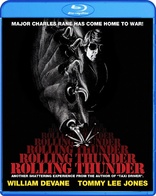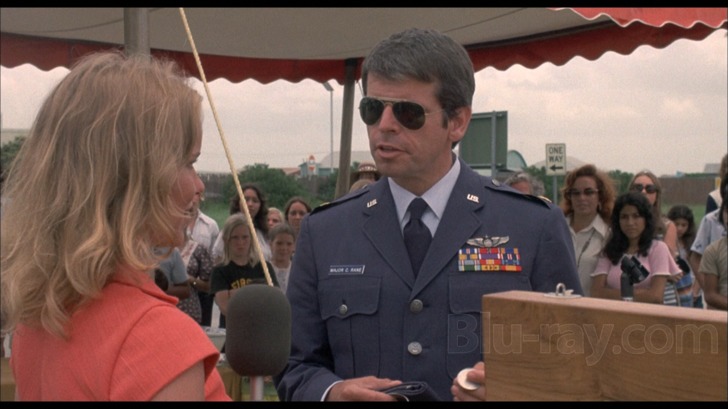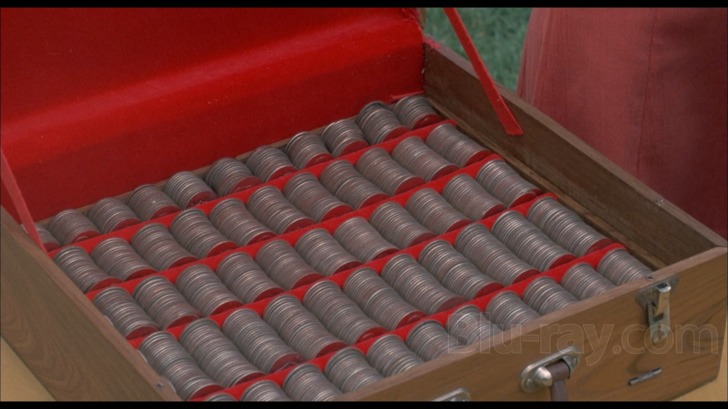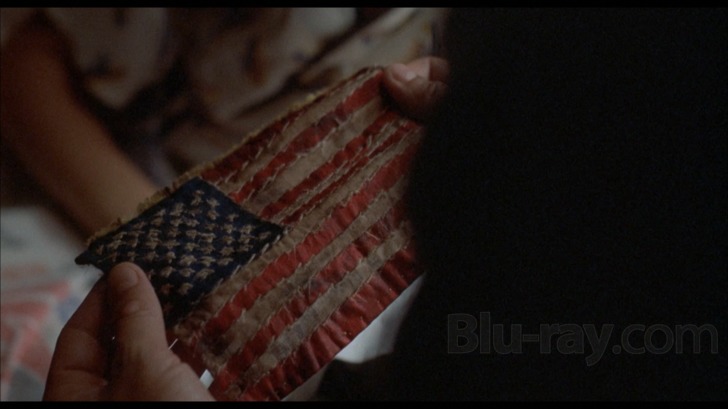Rolling Thunder Blu-ray Movie
HomeRolling Thunder Blu-ray Movie 
Shout Factory | 1977 | 100 min | Rated R | May 28, 2013
Movie rating
7.4 | / 10 |
Blu-ray rating
| Users | 3.8 | |
| Reviewer | 3.5 | |
| Overall | 3.5 |
Overview
Rolling Thunder (1977)
Major Charles Rane comes back from the war and is given a number of gifts from his hometown because he is a war hero. Some greedy thugs decide that they want to steal a number of silver dollars from him. In the process they also manage to kill his wife and son and destroy his hand. The Major wants revenge so he enlists the help of his war buddy Johnny to meet the thugs in a final showdown.
Starring: William Devane, Tommy Lee Jones, Linda Haynes, James Best, Dabney ColemanDirector: John Flynn (I)
| Crime | Uncertain |
| Drama | Uncertain |
| Action | Uncertain |
Specifications
Video
Video codec: MPEG-4 AVC
Video resolution: 1080p
Aspect ratio: 1.85:1
Original aspect ratio: 1.85:1
Audio
English: DTS-HD Master Audio 2.0 Mono (48kHz, 24-bit)
Subtitles
English
Discs
25GB Blu-ray Disc
Single disc (1 BD)
Playback
Region A (locked)
Review
Rating summary
| Movie | 3.5 | |
| Video | 3.5 | |
| Audio | 4.0 | |
| Extras | 2.5 | |
| Overall | 3.5 |
Rolling Thunder Blu-ray Movie Review
Don't you just love the feel of a garbage disposal? Well, maybe not so much. . .
Reviewed by Jeffrey Kauffman May 23, 2013The first time I saw William Devane hawking precious metals on television and he uttered the priceless line, “Don’t you just love the feel of gold?”, I literally burst out into helpless giggling. Somehow the image of the erstwhile John F. Kennedy (The Missiles of October) and just for good measure Robert F. Kennedy (the off-Broadway comedy MacBird) evoking images of sitting amidst piles of Krugerands and caressing them lovingly, all for a right leaning audience (courtesy of the cable news channel these ads regularly appear on), just made me slightly giddy. Perhaps that love of tangible assets started for Devane as long ago as 1977 in Rolling Thunder, a film which includes a scene of Devane’s character, a former Vietnam prisoner of war, getting showered with silver coins at a celebratory fête honoring his return to his hometown. Rolling Thunder starts off as a rather penetrating analysis of the trauma many returning vets experienced, seemingly more so with Vietnam than perhaps previous conflicts (probably due in part to the country’s distaste for that particular conflict), almost reminiscent in a way of Coming Home, a film that actually was released a year after Rolling Thunder. But then this film takes a decided left turn into Death Wish territory when a tragic series of killings leaves Devane’s character intent on revenge.

Major Charles Rane (William Devane) has been held captive as a POW in Vietnam for seven long years, enduring unthinkable torture. He’s now on his way home to San Antonio, Texas, along with his POW buddy Sergeant Johnny Vohden (Tommy Lee Jones) and several other freed men. (You’ll note the soldiers are rather anachronistically being flown in a private Lear jet—the Air Force, despite having a huge base in San Antonio, resolutely refused to lend any assistance to the filming in terms of providing materiel or location opportunities.) Johnny is met by his family and heads off to his home in El Paso, while Rane is reunited with his wife Janet (Lisa Blake Richards) and son Mark (Jordan Gerler), a young boy who was only a toddler when his father left for the war and who has no memory of his father. Janet proclaims she was too nervous to drive and enlisted the aid of local cop Cliff (Lawrason Driscoll) who acts as chauffeur, but who also seems awfully chummy with both Janet and Mark.
Rane attempts to bond with Mark during his first night at home, surprised when the young boy proffers a tiny American flag that he had found in the living room, a swatch of material Rane had crafted while in captivity and which remained one of his anchors and beacons reminding him of home. Rane also wants to go target shooting with Mark, something that makes the kid’s eyes light up. But when Rane has his first real talk with Janet, she relays the devastating news that she has been “seeing” Cliff and has agreed to marry him. Rane takes this all incredibly stoically, though a montage shows him reverting to the exercise regimen he utilized to keep himself sane in his long years of captivity. There’s a disturbing scene in this segment where Cliff comes to the shed where Rane tends to hide out (perhaps because it reminds him of his former prisoner of war cell) and tries to talk to him about the situation. Rane, leering almost lasciviously, tells Cliff he knows that Cliff is curious about what kinds of torture Rane endured, proceeding to demonstrate one technique with Cliff’s forced complicity until Cliff finally backs away and refuses to participate. Obviously, things are not well in Rane’s psyche, even if he pretends to be calm in front of his Air Force counselor (Dabney Coleman).
Rane moves on to cutting down the sign his town has erected urging Hanoi to free him and then being showered with silver coins and a Cadillac convertible by the adoring crowds at San Antonio. (This part of the film seems almost deliberately at odds with the simmering subtext of Vietnam vets returning to an uncaring American public.) Things seems to be at least healable, given enough time, and Rolling Thunder up to this point seems to be a rather quiet though incisive look at the psychological turmoil vets like Rane go through upon their matriculation back into stateside life. But then the film does something quite unexpected. Rane returns home to be greeted by a bunch of thugs out to claim his silver (which isn’t even worth that much). Rane refuses to divulge where he’s hidden it, at which point the goons start mercilessly torturing him, including shoving his hand down a garbage disposal. All those years in a Hanoi prison worked their particular magic, though, and Rane doesn’t crack. That changes when Janet and Mark return home, and Mark, terrified to see his father in such a sad state, instantly tells the thieves where the silver is hidden. The bad guys not only retrieve the money, they shoot the Rane family and leave.
Rane awakens in a hospital to the loss not only of one of his hands (which is soon replaced with a metal hook) but also his wife and son. Interestingly, the film is rather discursive in this latter revelation, never really mentioning it outright and instead hinting at it through the comments of supporting players. Once again Rane seems to be strangely tamped down about it all, but there is a seething anger that is revealed once he returns home and begins filing down his hook into a sharp metal point. Obviously Rane, who has insisted to police (including Cliff) that he can’t remember a thing about the attack, has his own personal justice in mind.
That sets the film off on its violent third act, where Rane, accompanied by Linda (Linda Haynes), the lovely young woman who had presented Rane with the silver and who obviously harbors a major crush on the returning vet. Linda thinks it might be the romantic getaway she’s long pined for, but after a series of desperate interchanges with various bad guys, she realizes Rane is out for vengeance. Though she engages in a brief scuffle with Rane, she ultimately relents, and soon Johnny is also on hand to assist. This part of Rolling Thunder is graphic (the finale takes place in a bordello, with lots of naked women running around) and rather tonally disparate to the opening parts of the film.
Rather interestingly, Rolling Thunder was co-written by Paul Schrader, who had just sprung into mainstream fame (some would say infamy) for having written Taxi Driver the year previously. The films share several certain similarities, not the least of which is their depiction of a returned vet who ultimately gives in to his inner demons and unleashes a ferocious violence (with brothels being a location for at least some of that violence in both films). Taxi Driver is sometimes faulted (rightly or wrongly) for first saddling Travis Bickle with the combined weight of a generation’s post traumatic stress disorder and then having the audacity to iconize his obvious maladjustments. Rolling Thunder at least posits a hero, however flawed and maladjusted he in fact may be, responding to violence visited upon him. While Rolling Thunder encountered at least as much hostility as Taxi Driver did (stories are still legion about test screenings gone horribly awry, resulting in physical altercations), at least this film has a certain moral certitude that the more ambiguous Taxi Driver either intentionally or otherwise never sought to depict.
Rolling Thunder Blu-ray Movie, Video Quality 

Rolling Thunder is presented on Blu-ray courtesy of Shout! Factory with an AVC encoded 1080p transfer in 1.85:1. I have no definitive information at my fingertips, but a cursory glance at the screenshots included in our Blu-ray review of the U.K. Edition by my colleague Dr. Svet Atanasov indicates that this may have been struck from the same master, as colors are virtually identical (I don't have the U.K. release myself, and am going solely by screenshots, not always the most reliable guide). That said, I'm perhaps a bit less sanguine about the results than Svet was in his review. The elements seem slightly faded at times, which is not a huge deal, but this transfer has noticeable mosquito noise in several of the darker sequences, something that proves to be the most distracting anomaly of this high definition presentation. That said, as Svet noted in his review of the U.K. edition, this Shout! Factory release has a very filmic appearance, and when brightly lit daytime scenes are on hand, fine detail pops quite admirably.
Rolling Thunder Blu-ray Movie, Audio Quality 

Rolling Thunder features a DTS-HD Master Audio Mono mix presented via DTS-HD Master Audio 2.0. While rather narrow sounding, the track has some decided "oomph" in the low end that makes the many shootouts especially exciting. Dialogue is very clearly presented and the Glen Campbell-esque opening theme (by Barry DeVorzon, who shared an Oscar for "Bless the Beasts and the Children") sounds fine.
Rolling Thunder Blu-ray Movie, Special Features and Extras 

- The Making of Rolling Thunder (1080i; 21:49) is a rather interesting piece which features interviews with Devane, Jones, and Schrader. All three of them try to steer away from seeing any political implications in the film. Devane states pertty explicitly, and Jones does by implication, that they view the film as nothing other than a basic revenge drama.
- Theatrical Trailer (1080p; 2:31)
- TV Spot (1080p; 00:32)
- Radio Spots (3:11)
- Photo Gallery (1080p; 2:07)
Rolling Thunder Blu-ray Movie, Overall Score and Recommendation 

Probably due to its schizophrenic structure, critics have long debated what exactly Rolling Thunder is trying to say. Lots of analysts have wanted to stuff this film into the "disturbed returning vet" genre (if that can even be termed a genre, as Tommy Lee Jones himself states in the supplementary featurette included on this Blu-ray), but when the stars and even the writer aver that this was more or less a revenge film, pure and simple, it's hard to really argue with them. There are some really fascinating parallels to Schrader's Taxi Driver here that may intrigue some who have neither seen nor in fact heard of Rolling Thunder. This Blu-ray features very good (if occasionally problematic) video, excellent audio and an interesting supplementary featurette. Recommended.
Similar titles
Similar titles you might also like

Saw X
2023

The Annihilators
1985

Death Wish 3 4K
1985

Exterminator 2
1984

Death Wish 4: The Crackdown
1987

Vigilante 4K
1982

The Exterminator
Unrated Director`s Cut
1980

Death Wish V: The Face of Death
1994

Defiance
1980

Death Wish II 4K
Slipcover in Original Pressing
1982

Death Wish 4K
1974

Savage Salvation
2022

Class of 1984
Collector's Edition
1982

The Hills Have Eyes
Unrated Edition
2006

Walking the Edge
Standard Edition
1985

Ms .45 4K
Limited Edition
1981

Contraband
Luca il contrabbandiere | Standard Edition
1980

Women in Cages
1971

The Stone Killer
Limited Edition to 3000
1973

Act of Vengeance
Rape Squad
1974
